What Is the Most Common Material Art Maers Use
Everyday Objects Perfect for Mixed Media Artists
To take mixed media art to its heights, y'all have to exist a bit of an adventurer — a tinkerer — a risk taker. Rae Missigman is all the above when it comes to her art. But she'due south a detective as well. She sleuths out the common tools and everyday objects we walk by every 24-hour interval that are perfect for making art marks. Rae shares the essential tools she's discovered for mark-making in her book, Paint-Play-Explore: Expressive Mark-Making Techniques in Mixed Media.Discover how you lot tin can invent and reinvent endlessly with Rae's top found objects and common tools shared here.
Brushes, Straws, Sponges and More
Upcycled tidbits offer a unique set of relatively common tools for marking making that tin yield boggling results on the folio. Reusable instruments such as plastic knives, combs, brushes, straws and stirrers can exist used to create the simplest of organic marks, such as lines, circles, dots and scratch marks. Pieces of bubble wrap, cardboard tubing, fruit netting and sponges will each leave an unusual imprint when coupled with the same mediums — smudges, rings, hash marks, peaks and valleys, each mark uniquely different each time they are applied. Cotton swabs, gift cards, droppers and even nail polish all have the power to create singular marks within a piece of art. Swipes, stripes, drips and splatters: each upcycled tool creates random nonetheless repetitive marks that cannot be duplicated, merely replicated—the beauty of their raw and disposable forms.
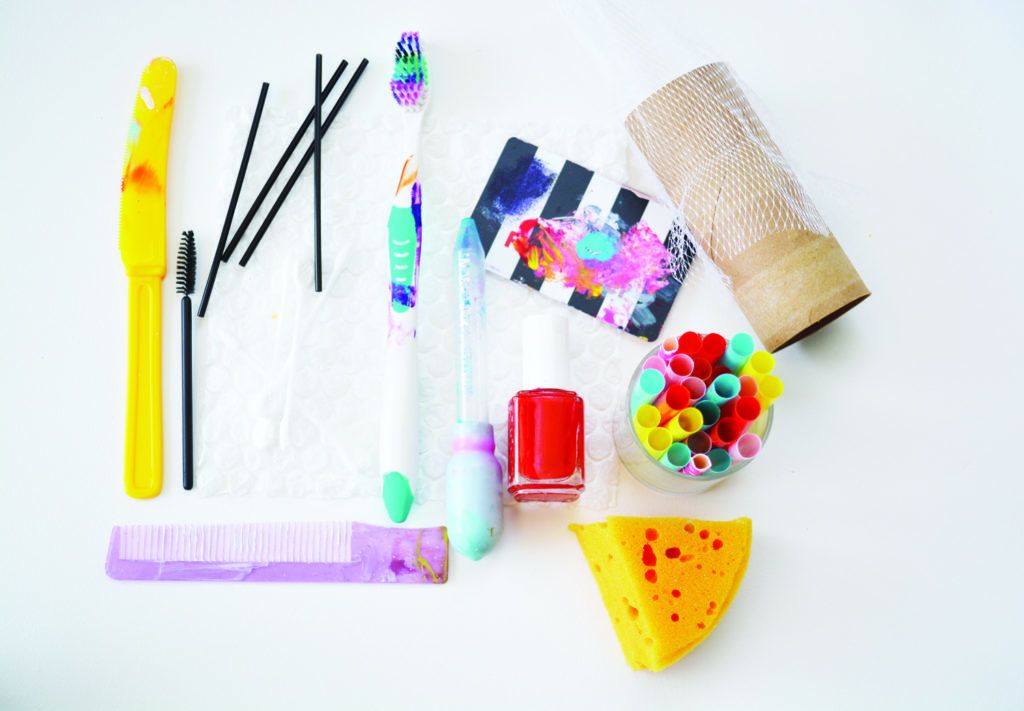
Pairings and Methods
Merged with an array of mediums, each of these basic marks volition appear differently according to the medium it is paired with when practical to a specific substrate. While paint volition get out heavier, toothier marks, inks paired with these tools will get out marks that appear less defined, more than abstract and blended. Nail polish can be practical with precision and form specific marks of color, or its wand can be used to spatter the paint across the page in an uncontrolled swathe. An upcycled toothbrush can be used to apply ink or pigment in a pattern specific to its head shape, or it can be used to pull and drib the ink beyond the surface of your work. A sponge can exist used to add together simple impressions to a substrate, or it can be paired with a watery ink and used to add a wash of colour to the entire surface.
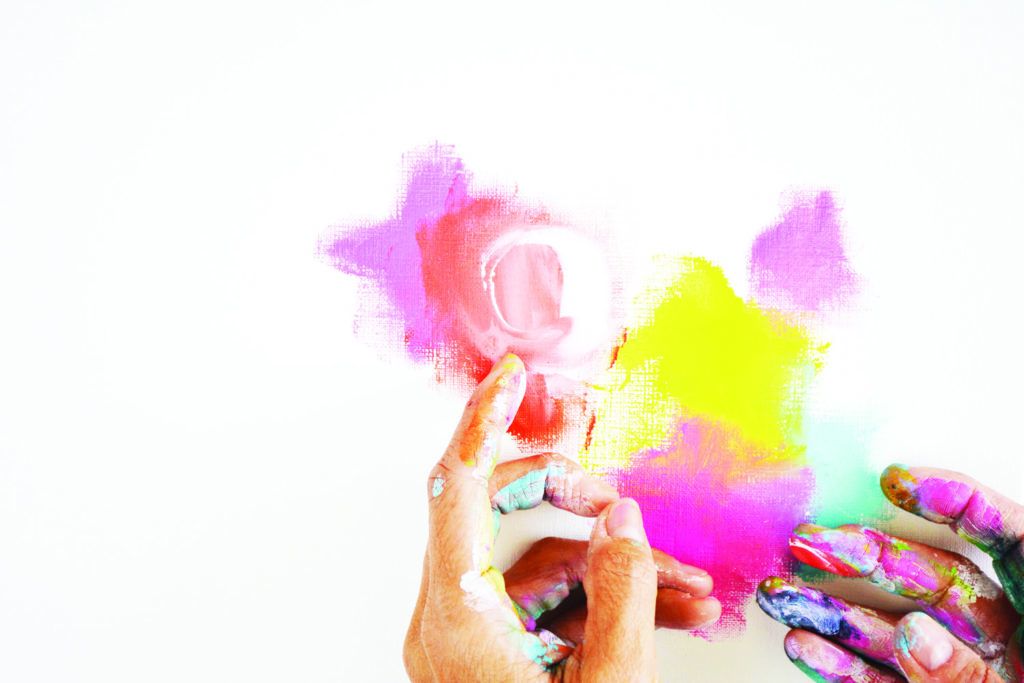
Fingers and Hands
Think of your hands equally a born brayer, assuasive you to motion paint and other wet mediums beyond the surface of your canvass quickly and in large sweeps. Without the added extension of an exterior tool, your fingers and hands let your marks to be added in both a fluid and defined manner. In creating with these takealong tools, you will find that using your hands and even your lower forearms can add an unexpected and delightful layer to your work. The results are both surprising and unique: Each artist'south hands leave their own distinct texture backside in their wake. Just every bit your easily are a brayer, your fingers are your brushes, varying in size and shape and each leaving a detailed and unique mark with each stroke.
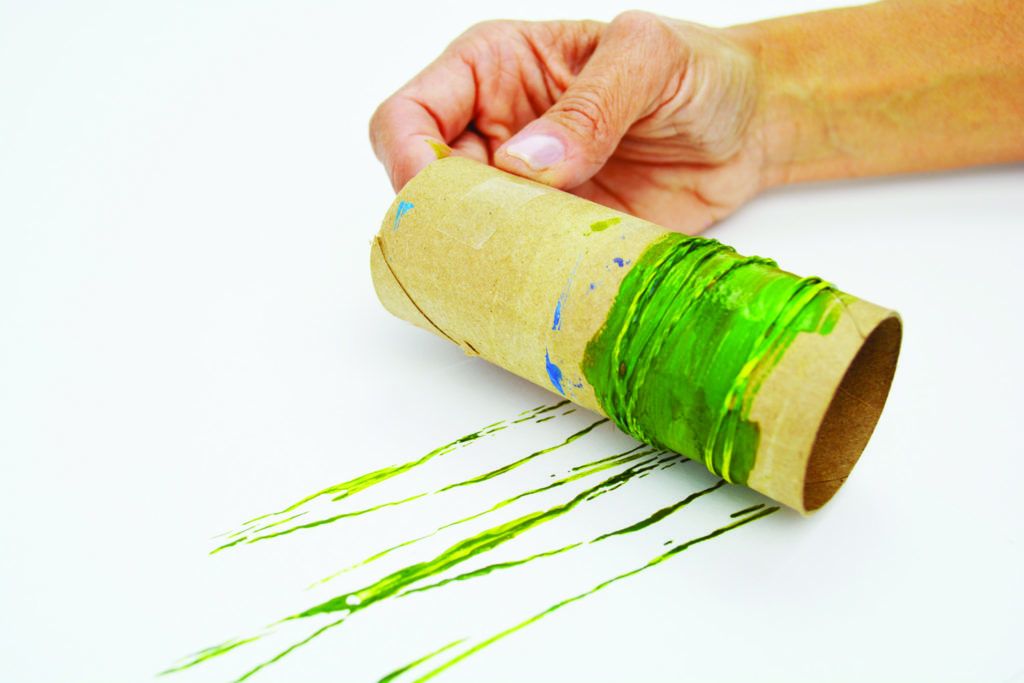
Chimera Wrap and Rubber Bands
Wrap one one-half of a cardboard tube with elastic bands in contrasted sizes. Use two-sided tape to adhere a piece of chimera wrap to the other side of the tube. You may cull to wrap an entire tube in either rubberband bands or bubble wrap, resulting in a wider finished application of each type of print. Add paint to the chimera wrap on your cardboard tube. Yous can simply brush the paint on for a thinner, more precise impression when rolled, or you can roll the wrapped tube directly into the pigment, which will effect in a thicker, less defined print. Roll the loaded wrap over paper to make the print. Remove the wrap or permit it dry out before using again to avoid mixing the colors.
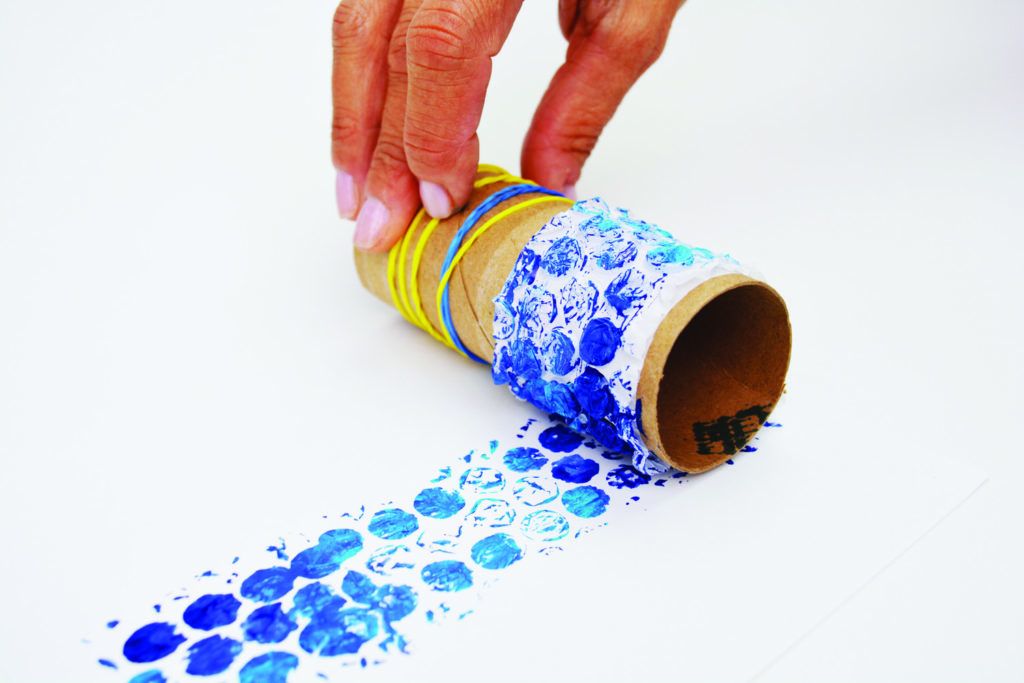
Use a heavily loaded brush to paint all of the rubberband bands on the cardboard tube. The cardboard will desire to soak up some of the wet paint, so a heavier application will result in a more defined print of the bands when rolled. Keeping the bands about one end of the tube volition make information technology easier to curl once the pigment is practical. Gyre the loaded paper-thin tube across your substrate in a quick, fluid motility. Repeat the motion until all of the bands have been exhausted of color. Crisscross the marks as y'all roll to become interesting and painterly lines. The bands volition get out a slight ridge along the edges of the color, adding even more dimension to the marks as they dry.
Cardboard Tubes
You tin cut, fold and reshape cardboard tubes into a huge array of marker making shapes; all the same, the natural circular form makes a groovy marking for larger projects. You can reuse these equally they dry out or cut them downwardly and start fresh with a new color. Just dip in pigment and printing gently but firmly onto your substrate.
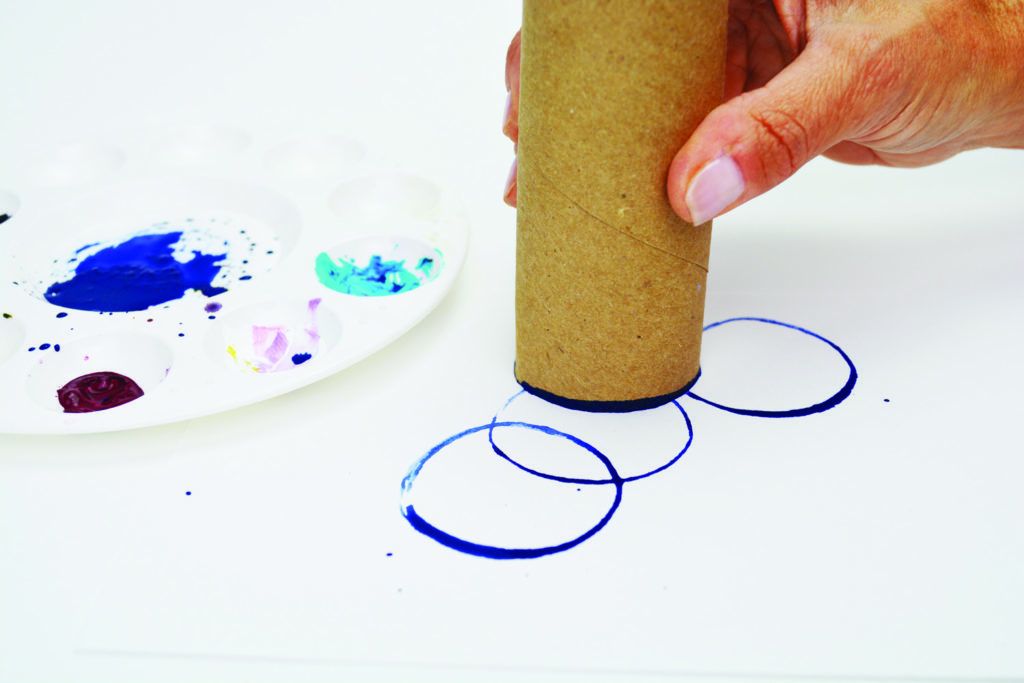
Drinking Straws
Similar to their larger counterparts, drinking straws tin can be cutting and shaped like the cardboard tubes. These are great marker makers and get out a less than perfect imprint when heavily loaded with paint. For larger projects, consider using an elastic band to secure several straws together to create i big multipoint tool.
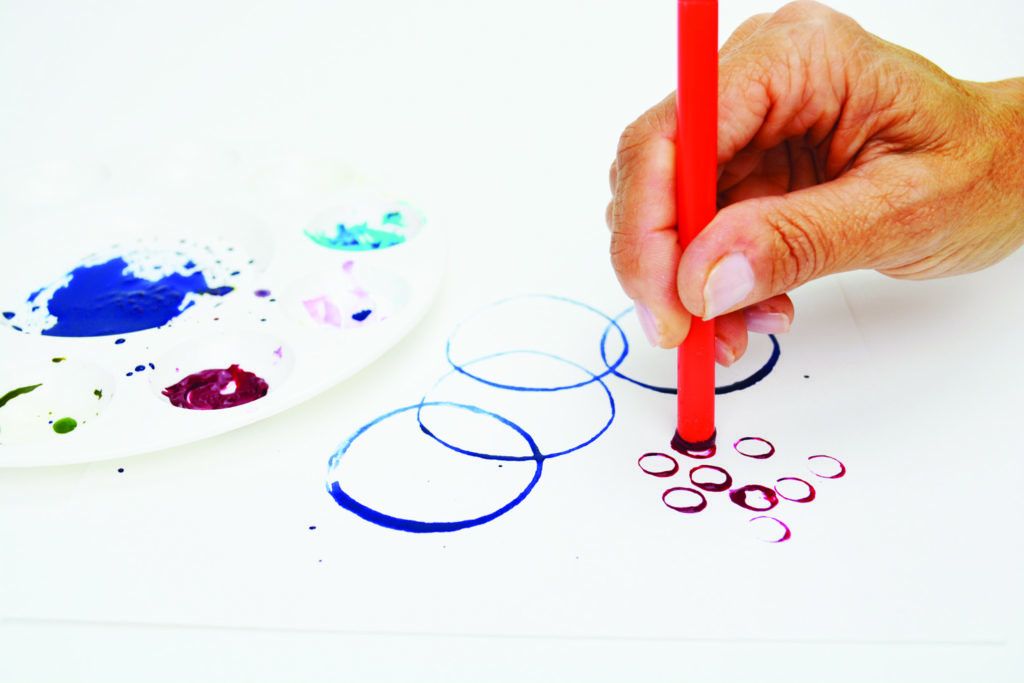
Key Cards
Heavy-duty plastic cards are a slap-up repurposed tool. Dipped in paint, the border of the bill of fare can be used to make painterly lines. Rocking the card back and forth as you lot apply the pigment to your substrate will create modest valleys in the paint that, when dry out, result in interesting texture. This aforementioned method likewise works well with texture pastes.
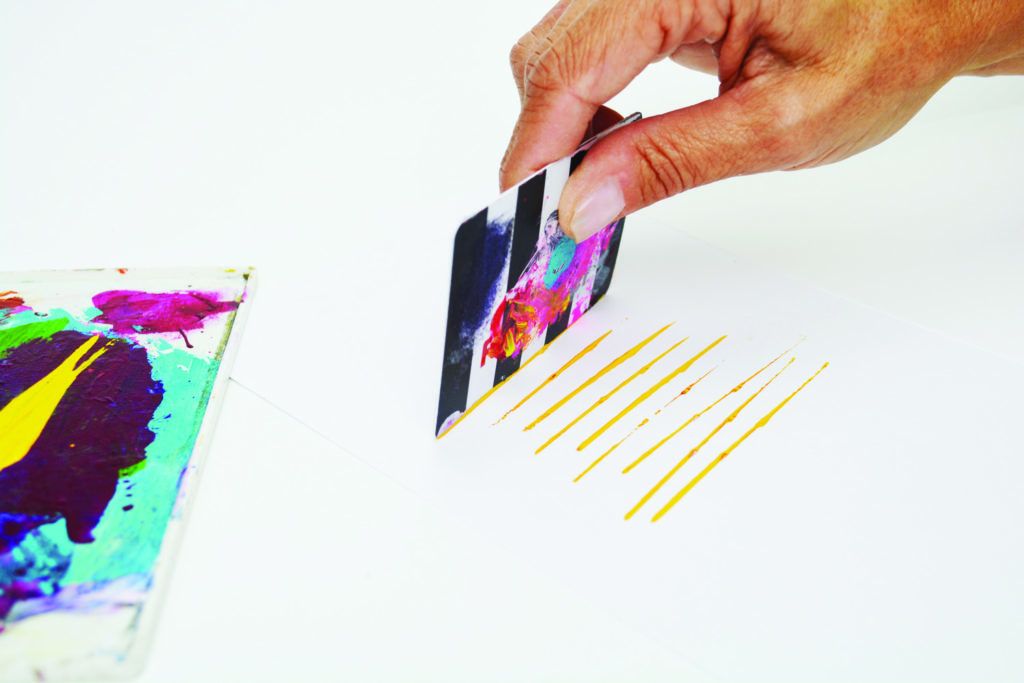
Fundamental cards are easily altered to create an fifty-fifty larger array of marks. Try wrapping the carte du jour with elastic bands in varying sizes. Dip the banded card into pigment and pull it beyond your substrate, rocking the card away from you every bit y'all pull. You can likewise snip minor pieces off of the card'south edge using heavy-duty scissors, to create interesting and decorative scrapers.
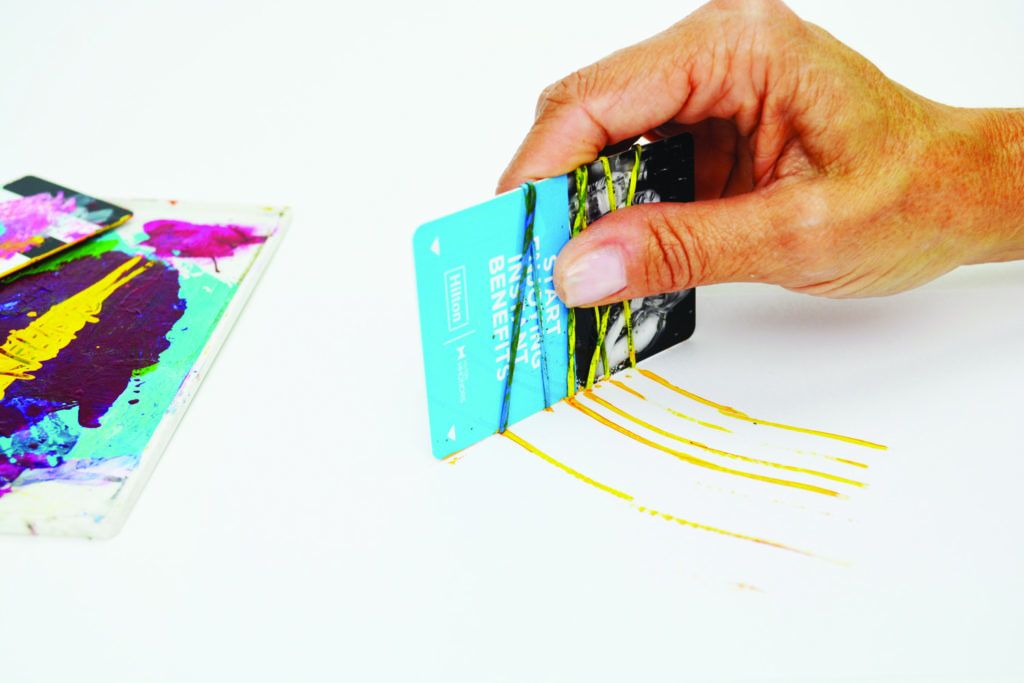
Makeup Wands
Makeup wands are a great tool for creating lots of small line marks apace. They are designed to exist heavily loaded with mascara and work wonderfully with paint and ink. Dip the wand in acrylic ink and brush along your substrate. The first stroke line volition be much heavier followed by thinner, more defined lines. Paint volition give an fifty-fifty heavier, less defined impression.
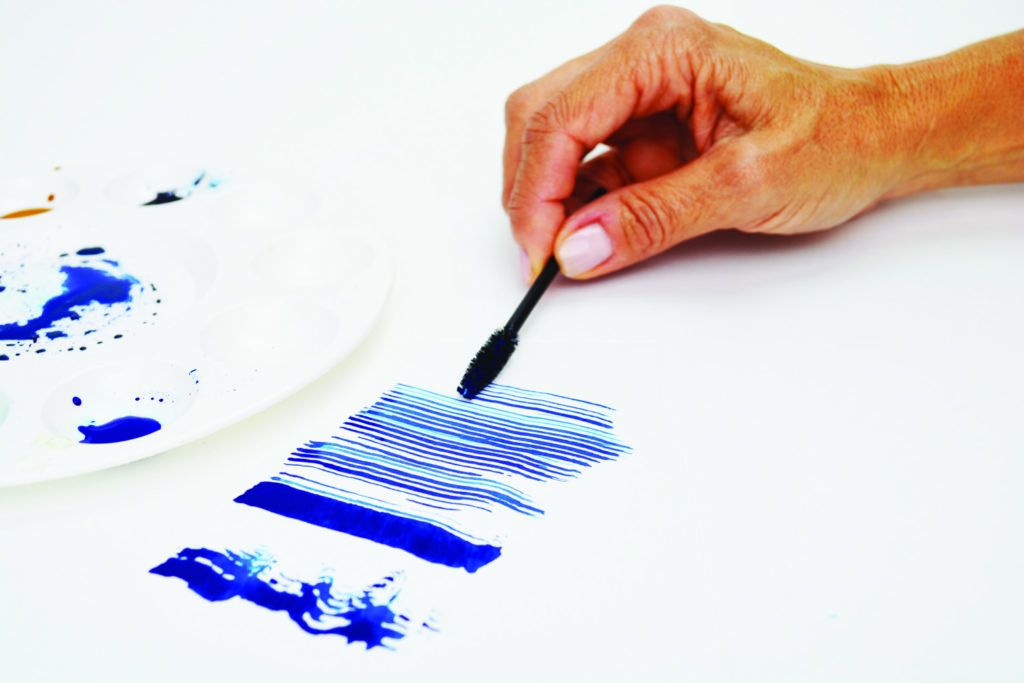
Cotton wool Swabs
Piece of cake to find and upkeep friendly, cotton swabs brand not bad marking makers and are handy in a pinch as a item brush. The absorbent quality of these tools make them great for ink and paint, allowing a longer open fourth dimension with the medium as you work. Many of these tools are double concluded, giving you the added bonus of working with two colors at once.
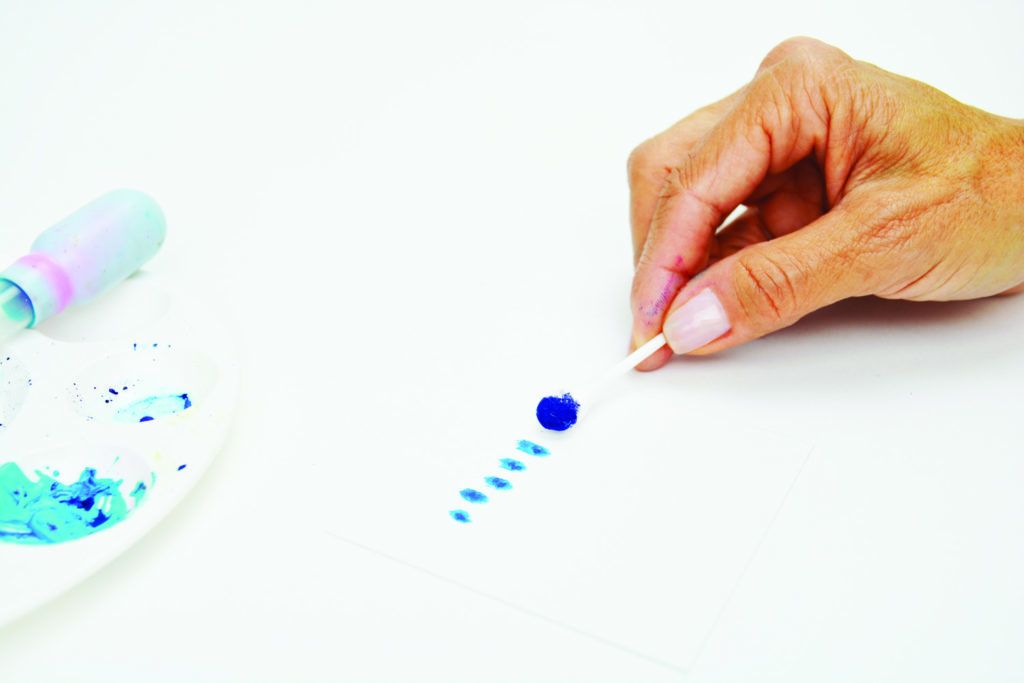
Sea Sponges
Dense sponges are perfect for making lots of interesting marks in your artwork. All-natural sponges will have a rougher, more irregular surface texture while the manufactured versions will have a smoother, more consistent exterior. Both are easily cut into smaller shapes. Utilise dry with paint or ink for defined prints or dampen before adding medium for more than fluid marks.
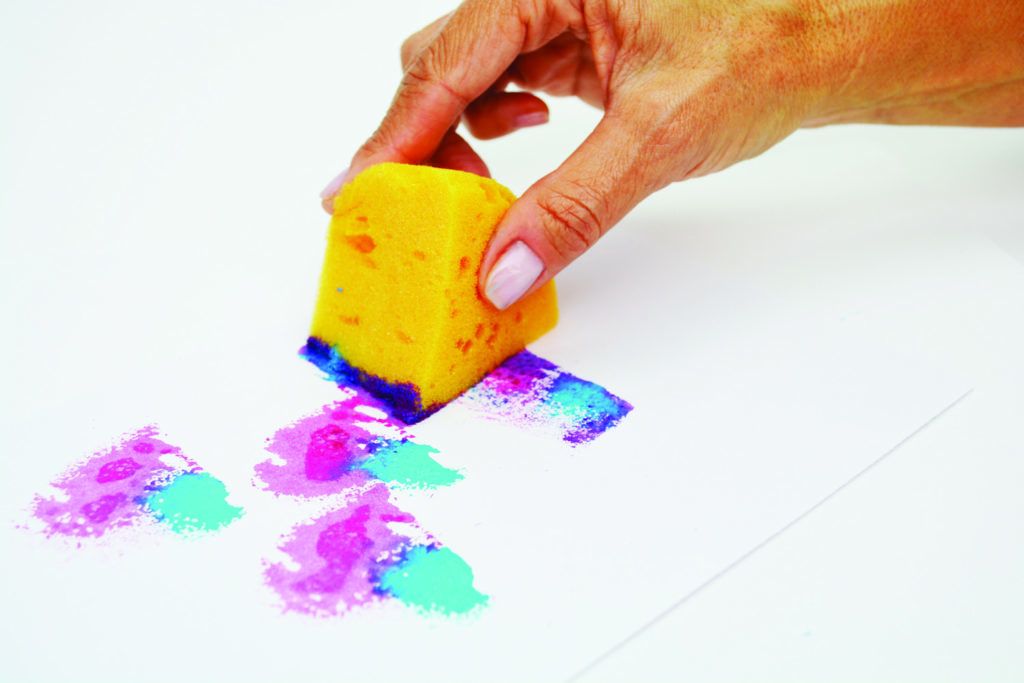
Clothespins
Use a recycled clothespin to create a series of nearly identical marks. Dip either of the ii wooden ends into pigment or ink, and press firmly onto your substrate. You lot will be able to brand a big number of marks apace given that every imprint will form ii marks.
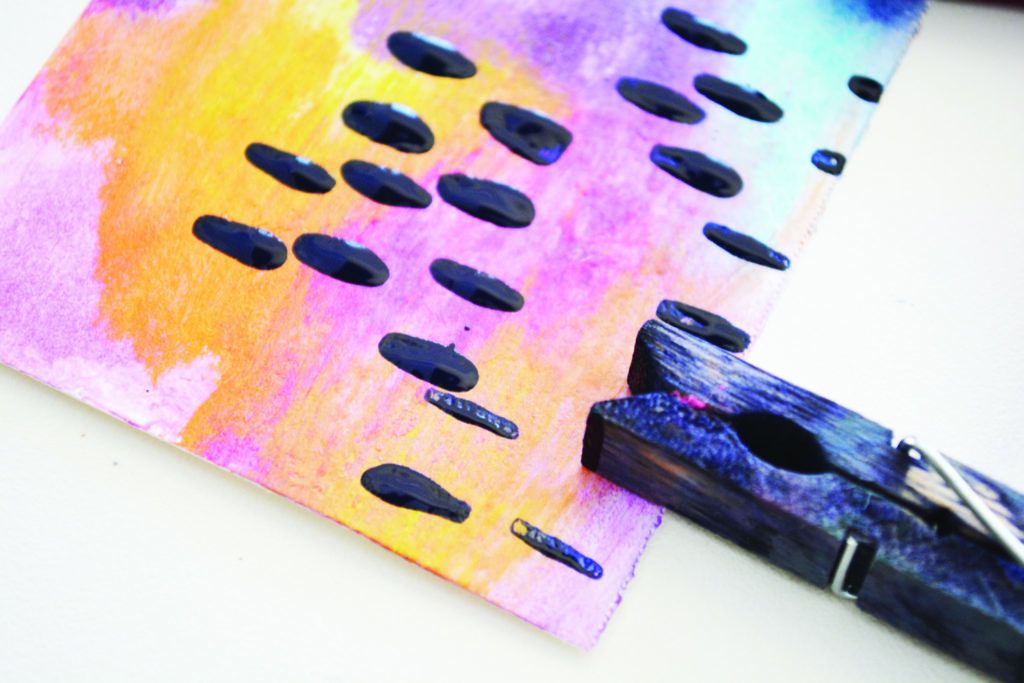
Leaves and Vegetables
Organic tools such as leaves, twigs, fruits and vegetables are interesting choices for mark-making tools in that they are truly unique by their very nature. No two leaves, twigs, fruits or vegetables will ever exist alike, thus their marks will be 1 of a kind. These tools tin can be used in a diverseness of ways, each offering an uncommon and distinct mark. Leaves, flowers and vegetables all leave wonderful impressions. Calculation paint and ink to these organic implements and using them every bit stamps is a delicate but rewarding process, leaving intricate and detailed impressions. Sticks and twigs make equally handy mark-making tools.
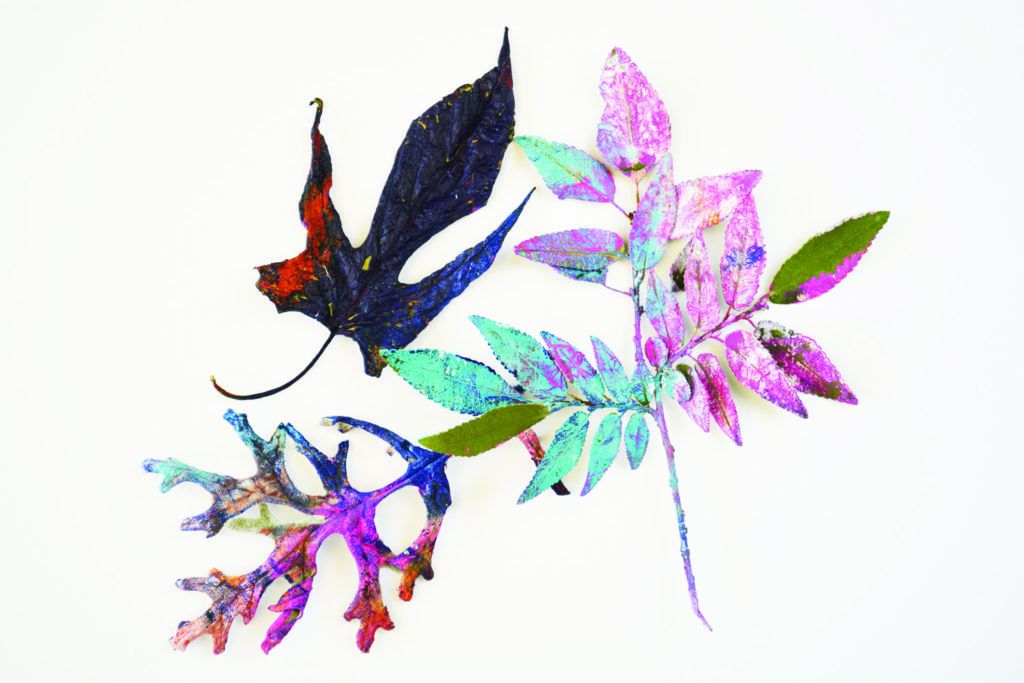
When dipped into wet mediums they can be used to describe or sketch simple, rudimentary marks and add delicate loose details beyond a foundation. A popular and gratifying technique that is easily coupled with these uncomplicated organic tools is monoprinting. You can create ane-of-a-kind layered prints using these living elements every bit simple masks on a printing plate. A word of caution: non all living elements make good tools. Always do your homework and stay away from all varieties of plants and flowers that are naturally poisonous or may cause allergic reactions. Consider gathering your organic implements from within the rubber of your ain garden or 1000, or consult a botanical guide earlier collecting your living tools.
Paintbrushes, Palette Knives and Brayers
Having a broad diverseness of paintbrushes with assorted head shapes and sizes will ensure you accept just the right tool to create specific marks as you piece of work. Palette knives bring dimension to the table and are indispensable when information technology comes to building texture and adding a unique sense of flavor to a slice of art. Choosing the right knife is requisite to adding a specific finish to a piece. Small, rounded blades are perfect for calculation pigment to small areas while wide, flat tips are best for spreading polish, even texture to a large surface. When searching for a truthful workhorse of a tool, you will demand to wait no further than your brayer. It has the power to spin a total and impactful groundwork on a big work in a short amount of time as well as ringlet the final touches across your piece, suddenly and fully bringing information technology to life.
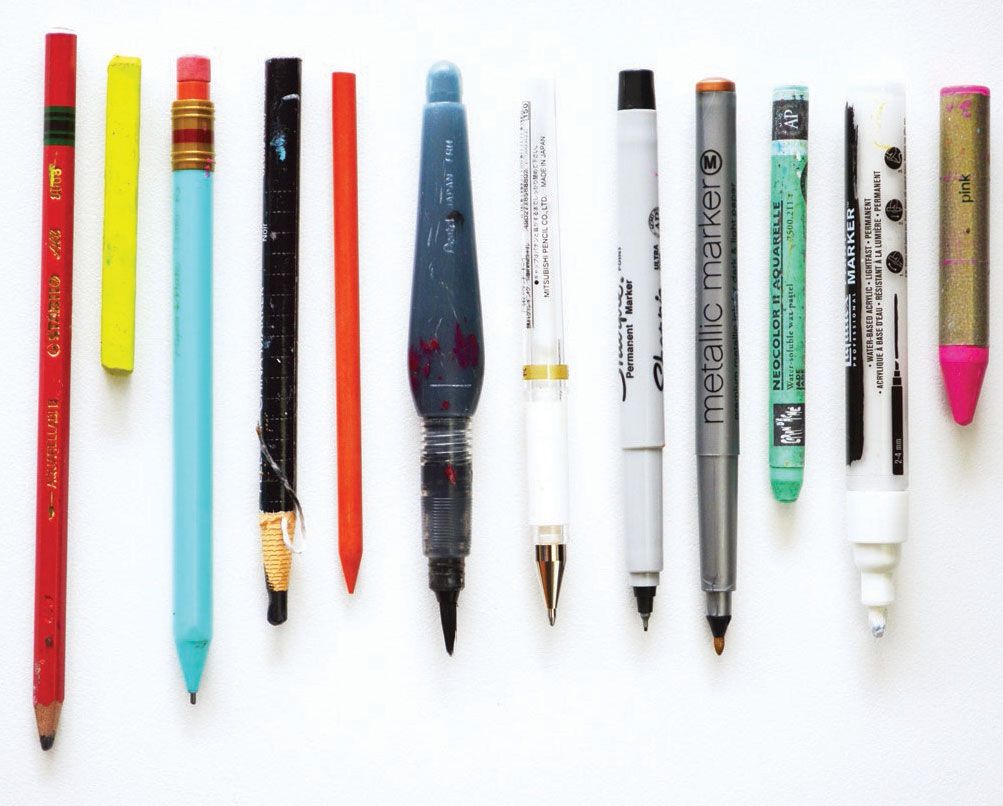
Writing Implements
Each of the most basic mark-making tools— pens, pencils, crayons, markers and ink-filled brushes— offer their own unique fingerprint when it comes to forming key marks. These simple writing elements are easy to assemble and provide you, the artist, with limitless opportunities for forming and shaping marks on a multifariousness of substrates. As you experiment with these elementary tools, yous will discover their private natures: some are flexible and yielding, allowing yous to create outside the bounds of their intended use; others are unbending and less manipulative in what they will allow you to return. Practice and play with each implement, stretching the limits of its intended use. Dedicate a periodical to making notes on all your mark-making tools. Observe how your writing implements respond to water, pigment and other mediums. Test them on all varieties of substrates and make notes then you can track what each tool does and how it reacts when paired with other elements. These rudimentary tools are the ones you will virtually frequently reach for when making your mark.
Explore More than Mark Making, Tools, and Art Tinkering
Mixed media artist Rae Missigman wears the proud badge of mark-making adventurer. In her book, Pigment-Play-Explore: Expressive Mark-Making Techniques in Mixed Media, she brings you more than threescore mark-making tools and mediums and two dozen demos on collage, monoprinting and more. Plus means to turn your marks into inventive art. Your copy is waiting for you!
Source: https://www.artistsnetwork.com/art-mediums/mixed-media/common-tools-mixed-media-art/
0 Response to "What Is the Most Common Material Art Maers Use"
Post a Comment